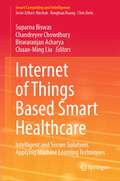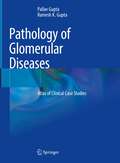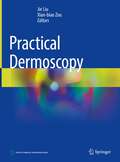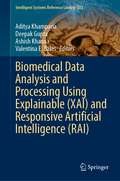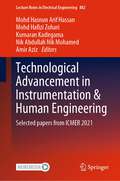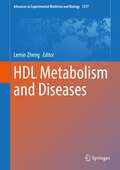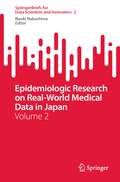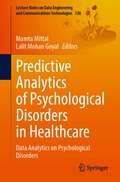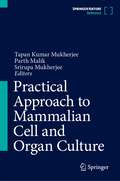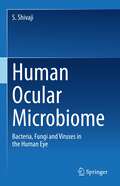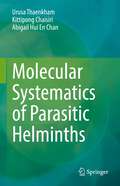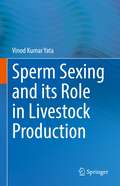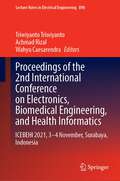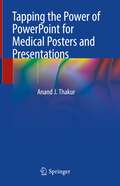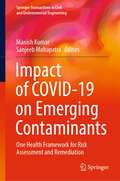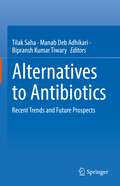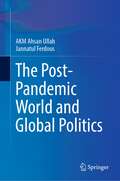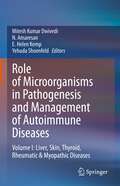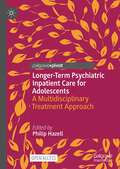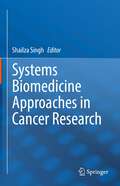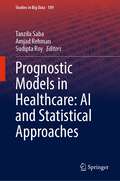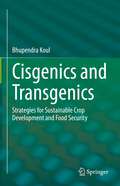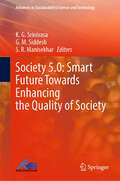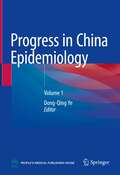- Table View
- List View
Internet of Things Based Smart Healthcare: Intelligent and Secure Solutions Applying Machine Learning Techniques (Smart Computing and Intelligence)
by Suparna Biswas Chandreyee Chowdhury Biswaranjan Acharya Chuan-Ming LiuThis book provides both the developers and the users with an awareness of the challenges and opportunities of advancements in healthcare paradigm with the application and availability of advanced hardware, software, tools, technique or algorithm development stemming the Internet of Things. The book helps readers to bridge the gap in their three understanding of three major domains and their interconnections: Hardware tested and software APP development for data collection, intelligent protocols for analysis and knowledge extraction. Medical expertise to interpret extracted knowledge towards disease prediction or diagnosis and support. Security experts to ensure data correctness for precise advice. The book provides state-of-the-art overviews by active researchers, technically elaborating healthcare architectures/frameworks, protocols, algorithms, methodologies followed by experimental results and evaluation. Future direction and scope will be precisely documented for interested readers.
Pathology of Glomerular Diseases: Atlas of Clinical Case Studies
by Pallav Gupta Ramesh K. GuptaThis book provides clear understanding of morphological appearances of various glomerular lesions encountered in a wide range of diseases involving renal glomeruli. Chapters cover various diseases with each chapter including a brief text and multiple colored microphotographs depicting the distinctive morphological features of glomeruli as may be encountered in these diseases. It presents complete clinical history with thorough lab workup and other related investigations as considered essential for proper evaluation of the patient. The book provides systemic approach for proper diagnosis of the underlying disease condition in view of the clinical workup and renal biopsy assessment. It provides visual understanding of the glomerular pathology that helps the consultant nephrologist to have a clear understanding of underlying renal disease thus helping in proper evaluation and appropriate therapeutic management of the patient. It may also guide to predict the likely prognostic outcome of the patient. This book is not only helpful to renal pathologists and nephrologists but also serves as a valuable resource for clear understanding of the glomerular lesions to the beginners and postgraduates in nephrology and renal pathology and other physicians managing the patients of renal diseases
Practical Dermoscopy
by Jie Liu Xian-biao ZouThis book aims to provide readers with practical information on the procedure of streamline skin disease recognition with the use of dermoscopy. The first three chapters are mainly focused on the basic knowledge of dermoscopy, such as its history, how it works, the terminology. In the following chapters, the clinical photographs, dermoscopic images and histopathologic images of benign melanocytic neoplasms, malignant melanoma, basal cell carcinoma, seborrheic keratosis and related diseases, vascular diseases, squamous cell neoplasms and other neoplasms are presented in a case-based format. The clinical characteristics are introduced briefly, and the dermoscopic features are highlighted with a number of pictures. The chapter 12 to chapter 14 introduce the dermoscopic appearance of inflammatory skin diseases, infectious and parasitic skin diseases, hair and nail diseases, respectively, which is the extended application of dermoscopy. Last but not least, the development and future of articifial intellegence assisted diagnosis based on dermoscopic images is introduced. Written by dermatologists who have been involved in dermoscopic diagnosis for a long time, this case-based book will be a valuable reference for dermatologists and those who are interested in related field.
Biomedical Data Analysis and Processing Using Explainable (Intelligent Systems Reference Library #222)
by Aditya Khamparia Deepak Gupta Ashish Khanna Valentina E. BalasThe book discusses Explainable (XAI) and Responsive Artificial Intelligence (RAI) for biomedical and healthcare applications. It will discuss the advantages in dealing with big and complex data by using explainable AI concepts in the field of biomedical sciences. The book explains both positive as well as negative findings obtained by explainable AI techniques. It features real time experiences by physicians and medical staff for applied deep learning based solutions. The book will be extremely useful for researchers and practitioners in advancing their studies.
Technological Advancement in Instrumentation & Human Engineering: Selected papers from ICMER 2021 (Lecture Notes in Electrical Engineering #882)
by Mohd Hasnun Arif Hassan Mohd Hafizi Zohari Kumaran Kadirgama Nik Abdullah Nik Mohamed Amir AzizThis book (Technological Advancement in Instrumentation & Human Engineering) gathers selected papers submitted to the 6th International Conference on Mechanical Engineering Research in fields related to human engineering, ergonomics, vibration, instrumentation, Internet of Things and signal processing. This proceeding consists of papers in aforementioned related fields presented by researchers and scientists from universities, research institutes and industry showcasing their latest findings and discussions with an emphasis on innovations and developments in embracing the new norm, resulting from the COVID pandemic.
HDL Metabolism and Diseases (Advances in Experimental Medicine and Biology #1377)
by Lemin ZhengThis book focuses on both high-density lipoproteins (HDL) metabolism and related diseases from the perspectives of the world-class experts in HDL. Several chapters in this book provide the overall information about HDL metabolism via detailed discussion of HDL structures as well as several key molecules involved in its functions, such as SR-B1 and Cholesteryl Ester Transfer Protein Inhibitors and so on. The rest of this book illustrates the connection between HDL and several diseases that are the major concerns of people’s health in many countries, and devotes to exploring the therapies of HDL related diseases. With a better understanding of the HDL metabolism and diseases, this book will benefit the audiences with interest in HDL from biomedicine to clinical practice.
Epidemiologic Research on Real-World Medical Data in Japan: Volume 2 (SpringerBriefs for Data Scientists and Innovators #2)
by Naoki NakashimaThis book analyzes the development of medical big data projects in Japan.Japan is experiencing unprecedented population aging, and labor productivity has decreased accordingly. Big data analysis of the Japanese medical real-world database (RWD) has the potential to tackle this issue.To allow readers to gain an understanding of Japanese medical big data analysis, the book discusses the original Japanese system that generates medical RWDs in the hospital medical records system, the nationwide standardized health checkup system, and the public medical insurance system in Japan.After introducing four major big data projects in the healthcare–medical field in Japan, the book explains the importance of creating information standards to maintain data quality and to analyze medical big data. It enables readers to analyze which standards are installed in which RWDs, how the standards are maintained, and which issues are prevalent in Japan.This book also describes the ethical processes involved in big data projects involving medical RWDs in Japan.
Predictive Analytics of Psychological Disorders in Healthcare: Data Analytics on Psychological Disorders (Lecture Notes on Data Engineering and Communications Technologies #128)
by Mamta Mittal Lalit Mohan GoyalThis book discusses an interdisciplinary field which combines two major domains: healthcare and data analytics. It presents research studies by experts helping to fight discontent, distress, anxiety and unrealized potential by using mathematical models, machine learning, artificial intelligence, etc. and take preventive measures beforehand. Psychological disorders and biological abnormalities are significantly related with the applications of cognitive illnesses which has increased significantly in contemporary years and needs rapid investigation. The research content of this book is helpful for psychological undergraduates, health workers and their trainees, therapists, medical psychologists, and nurses.
Practical Approach to Mammalian Cell and Organ Culture
by Tapan Kumar Mukherjee Parth Malik Srirupa MukherjeeThis Major Reference Work offers a detailed overview of culturing primary, secondary cell lines, tissues, and organs.It first introduces various types of mammalian cell cultures, infrastructure requirements for a mammalian cell-culture laboratory. The subsequent chapters present the detailed protocols for the isolation of mammalian hematologic organs and cells. It also discusses various cell-based assays for monitoring cell viability, cell proliferation, cytotoxicity, cell senescence, and cell death assays.In addition, the book addresses the various problems encountered while culturing animal cells, their possible causes, and suggested solutions, presenting detailed protocols for isolation and primary culturing of various mammalian cells and hematoimmunologic organs in two dimensions.Lastly, it reviews the various applications of animal-cell culture, stem-cell culture, and tissue and organ culture. As such, this reference book is highly relevant for students and professionals new to cell-culture work as well as to those wishing to expand their skills from cell-line cultures to primary cultures and from conventional 2D cultures to 3D cultures.
Human Ocular Microbiome: Bacteria, Fungi and Viruses in the Human Eye
by S. ShivajiThis book provides an integrated review of the human ocular microbiome. It documents the discovery of ocular surface microbes by the conventional cultivable method and next generation sequencing technologies in both healthy and diseased (keratitis, uveitis, endophthalmitis, blepharitis, conjunctivitis etc.) eyes. The book further discusses the confounding factors that influence the microbiome, mycobiome and virome. The chapters cover niche-specificity with reference to skin, eyelid- margin, hands etc. It highlights the concept of core genera, dysbiosis and discriminating genera and covers the functional relevance of the dysbiotic microbiome, mycobiome and virome with respect to ocular diseases. The book includes topics on the relevance of molecular mechanisms, including quorum-sensing and mucin metabolism to ocular disorders, such as dry eye; and, microbiome-based therapies for treating of ocular disorders like vernal keratoconjunctivitis. The book is essential for microbiologists studying the human eye, ophthalmologists treating eye infection and trauma. It also caters to students of medical microbiology and medicine.
Molecular Systematics of Parasitic Helminths
by Urusa Thaenkham Kittipong Chaisiri Abigail Hui En ChanThis book aims to provide fundamental knowledge and information for research in molecular systematics on parasitic helminths (nematode, trematode, cestode). The shreds of evidence of molecular systematics studies will be compiled and discussed in terms of the utilities and pitfalls of the genetic marker used for various purposes, which have been implemented for molecular systematics of parasitic nematodes, cestodes, and trematodes. Moreover, this book will also provide the procedure for research on molecular systematics and DNA taxonomy as the guideline to explore parasitic helminths. Finally, the further perspectives of utilizing genetic markers for molecular studies on parasitic helminths will be addressed in the context of applications from the laboratory to fieldwork such as DNA barcoding and environmental DNA metabarcoding of parasitic helminths. The book will benefit postgraduate students and researchers requiring the detailed knowledge of molecular systematics, as well as researchers desiring a guideline to select genetic markers and analyze DNA sequences to make phylogenetic inferences
Sperm Sexing and its Role in Livestock Production
by Vinod Kumar YataThis book presents basic principles and discusses the state-of-the-art methods of sperm sexing in livestock. It reviews the challenges and critical opinions on the conventional sperm sexing methods and characteristic features of spermatozoa of farm animals which could help to develop novel methods of sperm sexing. The book also presents principles and applications of flow cytometry for sperm separation. The chapters of the book elucidate methods and difficulties in developing sperm sexing methods. Notably, it covers recent research on immunological and nanotechnology-based sperm sexing methods. The book also provides information on the development of semen extenders. Towards the end, the book examines ethical and commercial aspects of sperm sexing. It is an ideal reference book for students, researchers and professionals working towards improving livestock production.
Proceedings of the 2nd International Conference on Electronics, Biomedical Engineering, and Health Informatics: ICEBEHI 2021, 3–4 November, Surabaya, Indonesia (Lecture Notes in Electrical Engineering #898)
by Triwiyanto Triwiyanto Achmad Rizal Wahyu CaesarendraThis book presents high-quality peer-reviewed papers from the International Conference on Electronics, Biomedical Engineering, and Health Informatics (ICEBEHI) 2021 held at Surabaya, Indonesia, virtually. The contents are broadly divided into three parts: (i) electronics, (ii) biomedical engineering, and (iii) health informatics. The major focus is on emerging technologies and their applications in the domain of biomedical engineering. It includes papers based on original theoretical, practical, and experimental simulations, development, applications, measurements, and testing. Featuring the latest advances in the field of biomedical engineering applications, this book serves as a definitive reference resource for researchers, professors, and practitioners interested in exploring advanced techniques in the field of electronics, biomedical engineering, and health informatics. The applications and solutions discussed here provide excellent reference material for future product development.
Tapping the Power of PowerPoint for Medical Posters and Presentations
by Anand J. ThakurThis book talks about developing and improvising upon medical presentations by equipping readers with critical technical tips and tricks to use popular presentation programs like PowerPoint or Keynote effectively. The book details numerous remedial measures for qualitative improvement of average medical presentations. It has three sections: first covers the general aspects of preparing a presentation; the second provides practical details and refinements of preparing a medical presentation; the last section deals with niceties of podium and webinar presentations. The chapters cover many serious mistakes and remedial measures to improve average medical presentations, such as a description of purposeful use of colors in a slide, a brief discourse on technicalities of appropriate clinical image formats for projection ensues; the use of drawing and photo-editing programs to inject excellence in the contents of a medical presentation to help it stand out in the crowd, details on the importance of lexical correctness- typography, line spacing and alignment to enhance the impact of the presented text and many more. Several short videos support and actively promote the viewpoints discussed in the text. This book elaborates on the exquisite art of creating remarkable medical presentations for a specialized audience. This book is a must-have for all healthcare professionals of all specialties and grades who make podium presentations in a medical conference webinar or submit posters for display.
Impact of COVID-19 on Emerging Contaminants: One Health Framework for Risk Assessment and Remediation (Springer Transactions in Civil and Environmental Engineering)
by Manish Kumar Sanjeeb MohapatraThe book brings out several unique perspectives of impacts of COVID-19 on the environment with special emphasis on the risk and remediation of emerging contaminants. Idea is to work out under the one health framework and comprehend not only scientific and technical aspects but also environmental, legal and policy aspects for water resources management. The obvious stress is given to the occurrence, fate and transport of geogenic, microbial and anthropogenic contaminants of emerging concern under the preview of the fact that antibiotic and antiviral use has been unprecedented during the global pandemic of COVID-19. At the same time, this edited volume touches upon the broader framework of integrated water resource management, as well as mitigation and removal strategies to put forward a holistic picture to the readers and policymakers. These contents are divided into three sections: a) monitoring, occurrence, distribution and fate of emerging contaminants; b) source and effects of these contaminants on the total environment; and c) treatment strategies, natural attenuation and mitigation.
Alternatives to Antibiotics: Recent Trends and Future Prospects
by Tilak Saha Manab Deb Adhikari Bipransh Kumar TiwaryThis book discusses prospective alternative approaches to fight bacterial infections to minimize the indiscriminate use of conventional antibiotics. It offers the current knowledge on research and development of alternative antibacterial agents such as probiotics, nanobiotics etc. while it also discusses newly emerging trends such as phage therapy, antibody therapy etc. The book highlights on the phytochemicals with potent antibacterial activities as alternatives to conventional antibiotics. Chemical modification to develop next generation antibiotics with enhanced efficacy has also been included. Such modifications are reported to overcome the inherent resistance of the parent antibiotics. Phage therapy and targeted antibodies are considered as potential alternative approaches to treat bacterial ailments and represent areas of cutting-edge research and have therefore been discussed with sufficient care. Mainly, the book highlights various approaches other than conventional antibiotics in treating bacterial infections. The scientific advancements in these areas will strengthen the ‘One Health’ approach benefiting human beings, animals and environment as well. This book is a comprehensive resource to cater researchers, biological scientists, herbalists and clinical practitioners with up-to-date information on antibacterials other than antibiotics.
The Post-Pandemic World and Global Politics
by A K Ullah Jannatul FerdousThe book examines the impact of COVID-19 on economic and political processes, contending that the global reaction to the pandemic has been the largest failure in scientific policy in a generation. Unlike earlier crises, it has impacted the world's leading economies while also paralyzing international ties, provoking diverse and far-reaching reactions. The authors posit that no effective global response has been launched in response to this global catastrophe. Rather, governments have implemented a variety of policies based on the costs of virus protection against financial closure and isolation. In doing so, there has been a resurgence in nationalism. This book aims to provide comprehensive understanding of how the pandemic has widened political gaps, and demarcates what the long-term consequences might be in terms of policies and economics in the wake of the pandemic. Of interest to scholars in political geography, development studies, international relations, public administration, and health science, this book presents key observations on existing theories of global politics pivoted around the COVID-19 pandemic, and its ramifications on individuals, groups, and ultimately, the nation state.
Role of Microorganisms in Pathogenesis and Management of Autoimmune Diseases: Volume I: Liver, Skin, Thyroid, Rheumatic & Myopathic Diseases
by Mitesh Kumar Dwivedi N. Amaresan E. Helen Kemp Yehuda ShoenfeldThis book in the two volume set provides comprehensive coverage on how microbial pathogens can subvert our immune system into responding against self and resulting into autoimmune diseases. In particular, the book covers the different aspects of linking gut microbiota dysbiosis with autoimmune mechanisms involved in disease development to identify future effective approaches based on the gut microbiota for preventing these autoimmune diseases.Contributions in the book focuses on the role of microbiota/probiotics and their distinct mechanisms exerted in management of autoimmune liver, skin, thyroid, rheumatic and myopathic diseases. This could help in better understanding to design therapeutic strategies that can be deployed to prevent these autoimmune diseases.The book has an interdisciplinary appeal and scholars with an interest immunology, medical microbiology and nutritional sciences will value its contribution. Overall, the book gives a new dimensions and insight in the aspects of microbial role in autoimmune disease pathogenesis and therapeutic aspects.
Longer-Term Psychiatric Inpatient Care for Adolescents: A Multidisciplinary Treatment Approach
by Philip HazellThis open access book describes the theoretical underpinnings and operational aspects of delivering longer-term inpatient psychiatric care to adolescents experiencing severe, unremitting mental illness. The authorship is drawn from the multidisciplinary team that supports the Walker Adolescent Unit, located in Sydney, Australia. The book begins with an account of the planning and development of the unit, an examination of the physical environment, and the adaptations that have been made to ensure its functionality. There follows a consideration of the therapeutic milieu. The book describes clinical processes such as admission and discharge planning, formulation and case review. There is information about the specific roles of professionals and the therapies that they provide. The book describes the steps taken to maintain and enhance the physical wellbeing of patients. There are chapters dedicated to governance, and to training and education. The final chapter describes how the unit responded to challenges created by the COVID-19 pandemic.
Systems Biomedicine Approaches in Cancer Research
by Shailza SinghThis book presents the applications of systems biology and synthetic biology in cancer medicine. It highlights the use of computational and mathematical models to decipher the complexity of cancer heterogeneity. The book emphasizes the modeling approaches for predicting behavior of cancer cells, tissues in context of drug response, and angiogenesis. It introduces cell-based therapies for the treatment of various cancers and reviews the role of neural networks for drug response prediction. Further, it examines the system biology approaches for the identification of medicinal plants in cancer drug discovery. It explores the opportunities for metabolic engineering in the realm of cancer research towards development of new cancer therapies based on metabolically derived targets. Lastly, it discusses the applications of data mining techniques in cancer research. This book is an excellent guide for oncologists and researchers who are involved in the latest cancer research.
Prognostic Models in Healthcare: AI and Statistical Approaches (Studies in Big Data #109)
by Sudipta Roy Tanzila Saba Amjad RehmanThis book focuses on contemporary technologies and research in computational intelligence that has reached the practical level and is now accessible in preclinical and clinical settings. This book's principal objective is to thoroughly understand significant technological breakthroughs and research results in predictive modeling in healthcare imaging and data analysis. Machine learning and deep learning could be used to fully automate the diagnosis and prognosis of patients in medical fields. The healthcare industry's emphasis has evolved from a clinical-centric to a patient-centric model. However, it is still facing several technical, computational, and ethical challenges. Big data analytics in health care is becoming a revolution in technical as well as societal well-being viewpoints. Moreover, in this age of big data, there is increased access to massive amounts of regularly gathered data from the healthcare industry that has necessitated the development of predictive models and automated solutions for the early identification of critical and chronic illnesses. The book contains high-quality, original work that will assist readers in realizing novel applications and contexts for deep learning architectures and algorithms, making it an indispensable reference guide for academic researchers, professionals, industrial software engineers, and innovative model developers in healthcare industry.
Cisgenics and Transgenics: Strategies for Sustainable Crop Development and Food Security
by Bhupendra KoulThis book presents up-to-date information on various vector-less/direct (physical, chemical) and vector-mediated/indirect (Agrobacterium-mediated) plant transformation techniques. It summarizes various strategies that facilitate a gene from lower organism to be expressed in higher plants and also in silico designing of synthetic gene for higher expression. It also highlights the importance of strong promoters to drive the expression of transgene(s). This book encompasses the advantages and drawbacks of cisgenesis and transgenesis, their implications towards sustainable crop improvement, and their future prospects. The importance, limitations, challenges, recent developments, and future prospects of molecular pharming is also discussed. The book concludes with a chapter that summarizes the major contribution of GM-crops towards global food security and economy, advances in genome editing for crop improvement, challenges and risk associated with the release of GM-crops, and the future of GM technology. This book is meant for students and researchers in the field of life sciences, food science, and agriculture.
Society 5.0: Smart Future Towards Enhancing the Quality of Society (Advances in Sustainability Science and Technology)
by K. G. Srinivasa G. M. Siddesh S. R. ManisekharThe book discusses Society 5.0 which fills the gap between cyber and physical space by providing a balanced environment between economic and social needs. The book is divided into two parts; part A focuses on various concepts related to Society 5.0 such as cyber space, physical space, information management and digital transformation. Part B discusses various integrated fields in Society 5.0, such as super-smart healthcare system, super-smart hospitality system, smart building, and transport management system. It also illustrates the concepts of big data, real-time analytics for smart Society 5.0 with an insight of real-time case studies.
Progress in China Epidemiology: Volume 1
by Dong-Qing YeThis book is intended to show the great achievements and valuable experience of Chinese public health practices and epidemiological theories and methods. It is conducive to expanding medical workers’ practical ability of disease prevention and control, and to bridging the gap between clinical medicine and public health.In part 1, it introduces the progress in epidemiology of 10 infectious diseases. In part 2, it covers 11 non-communicable diseases. The research method and prediction modelling and public health ethics are discussed in the 11 chapters of part 3. The contributors include epidemiologists and public health experts, as well as more clinicians, mathematicians, sociologists, philosophers (ethicists), bioinformatics and so on. Among them, there are not only professors from universities, but also researchers from scientific research institutes, and experts in the front line of disease prevention and control.
Cerebral Palsy: Perspective and Clinical Relation to Perinatal Complications/Events in Japan
by Yoshio MatsudaThis edited book presents the latest information on epidemiology, pathophysiology, diagnosis, therapy, and some current topics covering all aspects of cerebral palsy. It offers a novel interpretation of a group of lifelong movement disorders, which now is an accepted notion that the causes of cerebral palsy are multifactorial rather than birth asphyxia. The book is organized into three parts, and it begins with illustrating the perspective of the disease. Then focuses on the relationship between clinical features of perinatal complications/events and cerebral palsy. The last part offers a hot topic of the prevention and the latest therapy, such as hypothermia, neuroprotection, and stem cell transfer. Since there is no cure for this congenital motor disability of cerebral origin, effective strategies for primary prevention are highly desirable. Effective strategies require an understanding of causal pathways and the Editor wishes to disseminate the experience and knowledge through this comprehensive volume to the readers.Cerebral Palsy - Perspective and Clinical Relation to Perinatal Complications/Events is a valuable source for clinicians, researchers, and medical staff who deal with the management of pregnancy and delivery. It also attracts clinicians worldwide who are interested in recent updates on this field.
